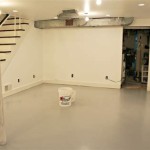Normal Radon Levels in Basement
Radon is a naturally occurring radioactive gas that can accumulate in homes, basements, and other enclosed spaces. It is a colorless, odorless, and tasteless gas that can pose significant health risks if levels are too high. Understanding normal radon levels in basements is crucial for homeowners and decorators to ensure a safe and healthy living environment.
What are Normal Radon Levels?
The United States Environmental Protection Agency (EPA) has established a radon action level of 4 picocuries per liter (pCi/L) of air. This means that any home or basement with radon levels at or above 4 pCi/L should be mitigated.
Radon Levels in Basements
Basements are often more prone to high radon levels than other areas of a home because they are typically below ground level and have less ventilation. Radon gas can enter basements through cracks in the foundation, walls, or floors.
Normal radon levels in basements vary depending on several factors, including:
- The local geology
- The construction of the basement
- The ventilation system
How to Test for Radon
The only way to know if your basement has high radon levels is to test for it. Several types of radon test kits are available, including:
- Short-term test kits (2-7 days)
- Long-term test kits (90 days or more)
Short-term test kits provide an estimate of radon levels over a short period, while long-term test kits provide a more accurate average of radon levels over a longer period.
Radon Mitigation
If your basement has high radon levels, it is essential to take action to mitigate the problem. Several radon mitigation systems are available, including:
- Sub-slab depressurization systems
- Active radon fans
- Passive radon vents
The type of radon mitigation system that is best for your basement will depend on several factors, including the radon levels, the size of the basement, and the construction of the basement.
Health Effects of Radon
Radon is the leading cause of lung cancer among non-smokers in the United States. Prolonged exposure to high radon levels can increase the risk of developing lung cancer, even in people who have never smoked.
The symptoms of radon exposure can include:
- Shortness of breath
- Coughing
- Chest pain
- Hoarseness
If you are concerned about radon exposure, it is important to test your basement and take action to mitigate the problem if necessary. Radon mitigation systems are effective in reducing radon levels and protecting your health.
Conclusion
Understanding normal radon levels in basements is crucial for homeowners and decorators to ensure a safe and healthy living environment. By testing your basement and taking action to mitigate high radon levels, you can protect yourself and your family from the health risks associated with radon exposure.

The Air Report Radon 2024 Edition

Radon Levels Radonresources Com

Report Faqs

Guide For Radon Measurements In Residential Dwellings Homes Ca

Acceptable Radon Levels In Home Testing And Remediation Md

How To Set Up A Radon Test Kit American Mitigation

Radon Levels Utah Services

Radon Levels By State Province Why A Test Is Essential Ecohome

Radon Levels In Georgia Contractor Tests Athens Winder Gainesville
Testing Your Home For Radon Utah Department Of Environmental Quality
Related Posts







